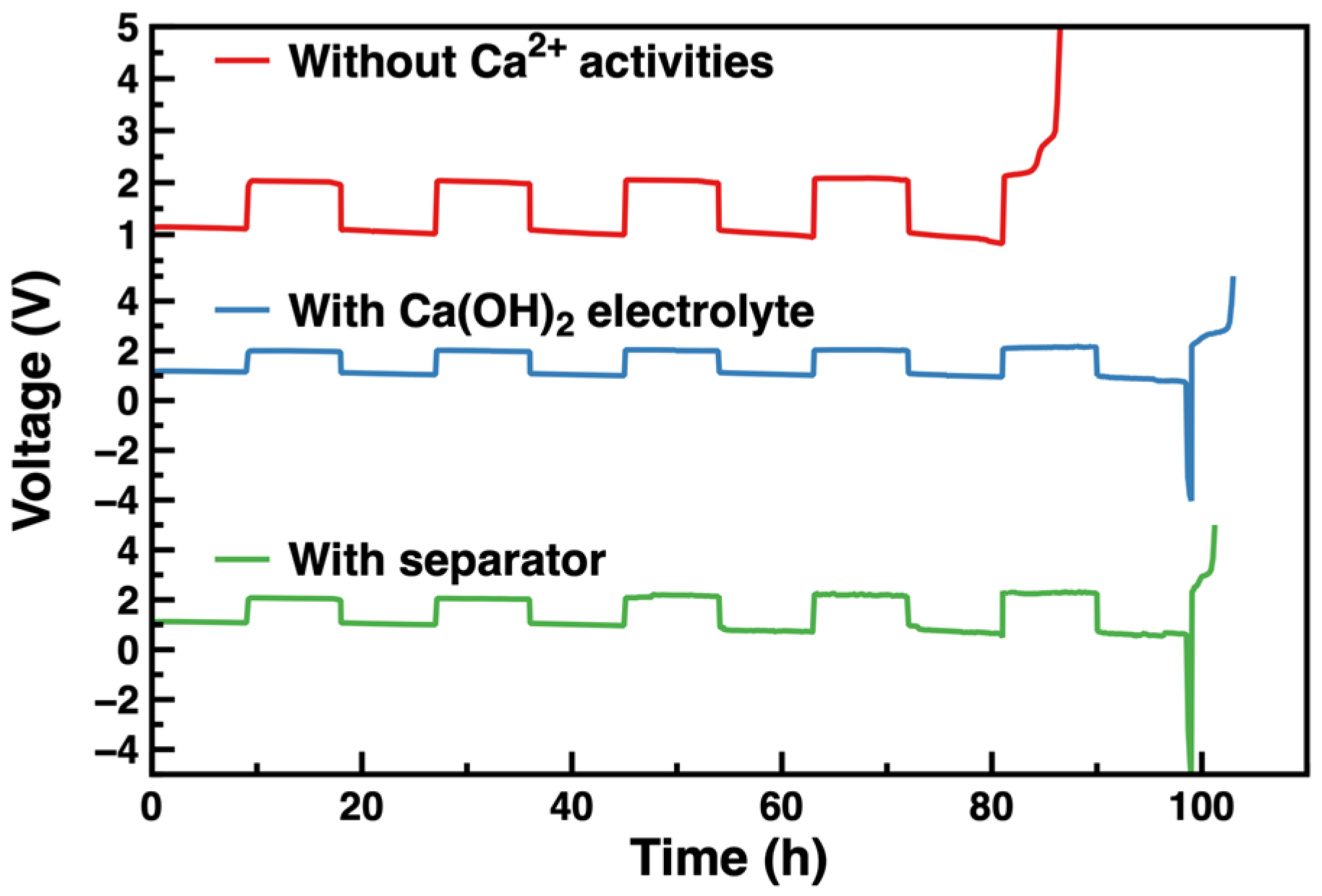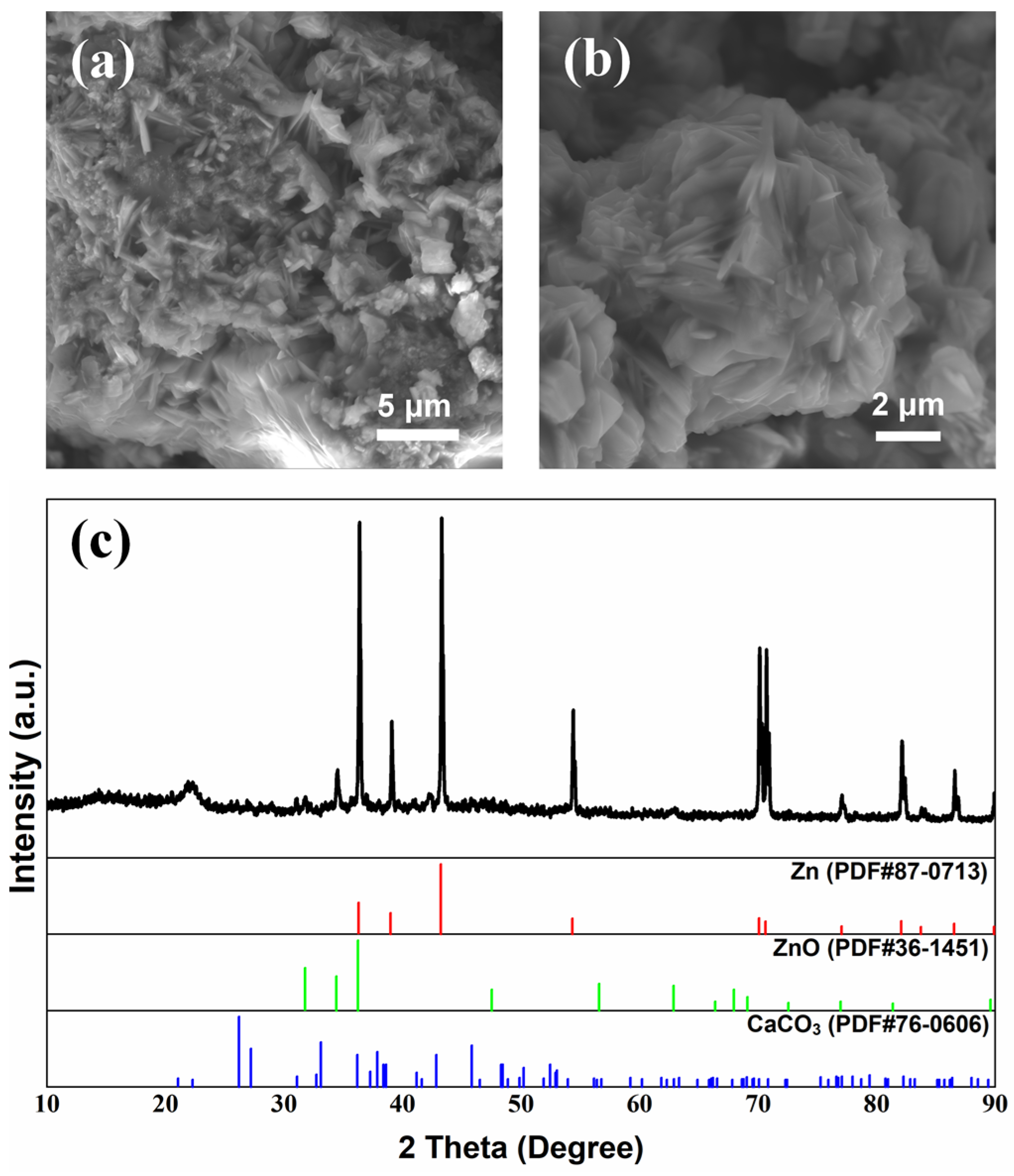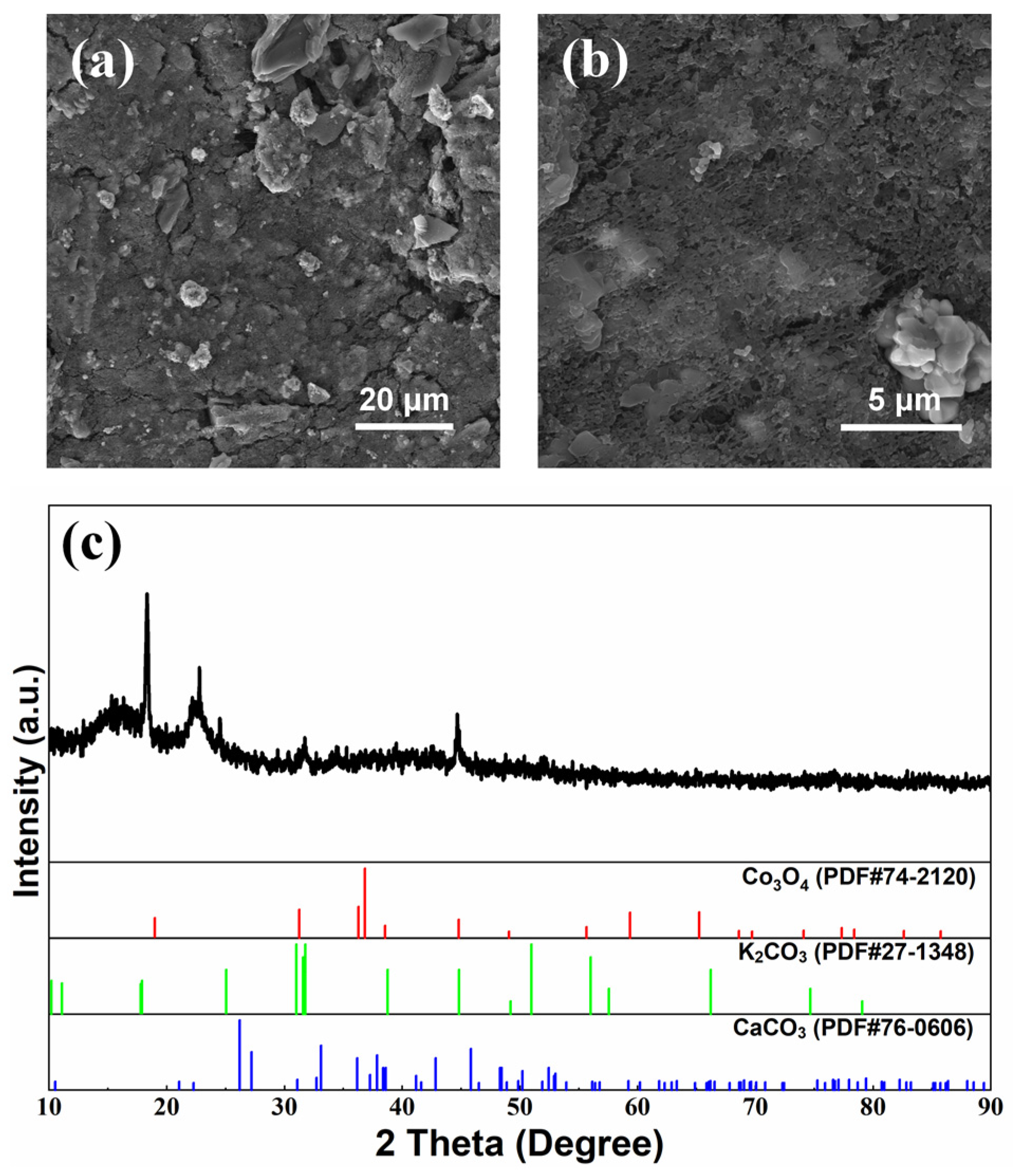Improving Cycle Life of Zinc–Air Batteries with Calcium Ion Additive in Electrolyte or Separator
Abstract
:1. Introduction
2. Experimental Section
2.1. Materials
2.2. Design and Assembly of ZAB
2.3. Methods
3. Results and Discussion
3.1. Charge–Discharge Cycle Performance
3.2. Morphology and Structure of ZAB Components
3.3. Mechanism of Ca2+ Additive to Improve the Cycle Life of ZABs
4. Conclusions
Supplementary Materials
Author Contributions
Funding
Data Availability Statement
Acknowledgments
Conflicts of Interest
References
- Lutkenhaus, J.L.; Flouda, P. Structural batteries take a load off. Sci. Robot. 2020, 5, eabd7026. [Google Scholar] [CrossRef] [PubMed]
- Li, Y.; Dai, H. Recent advances in zinc–air batteries. Chem. Soc. Rev. 2014, 43, 5257–5275. [Google Scholar] [CrossRef] [PubMed] [Green Version]
- Liu, X.; Yuan, Y.; Liu, J.; Liu, B.; Chen, X.; Ding, J.; Han, X.; Deng, Y.; Zhong, C.; Hu, W. Utilizing solar energy to improve the oxygen evolution reaction kinetics in zinc–air battery. Nat. Commun. 2019, 10, 4767. [Google Scholar] [CrossRef] [PubMed] [Green Version]
- Yang, Z.; Zhang, J.; Kintner-Meyer, M.C.W.; Lu, X.; Choi, D.; Lemmon, J.P.; Liu, J. Electrochemical energy storage for green grid. Chem. Rev. 2011, 111, 3577–3613. [Google Scholar] [CrossRef] [PubMed]
- Li, Y.; Gong, M.; Liang, Y.; Feng, J.; Kim, J.E.; Wang, H.; Hong, G.; Zhang, B.; Dai, H. Advanced zinc-air batteries based on high-performance hybrid electrocatalysts. Nat. Commun. 2013, 4, 1805. [Google Scholar] [CrossRef] [Green Version]
- Nie, Y.; Xu, X.; Wang, X.; Liu, M.; Gao, T.; Liu, B.; Li, L.; Meng, X.; Gu, P.; Zou, J. CoNi alloys encapsulated in N-doped carbon nanotubes for stabilizing oxygen electrocatalysis in zinc-air battery. Nanomaterials 2023, 13, 1788. [Google Scholar] [CrossRef]
- Chang, J.; Wang, G.; Yang, Y. Recent advances in electrode design for rechargeable zinc–air batteries. Small Sci. 2021, 1, 2100044. [Google Scholar] [CrossRef]
- He, Y.; Shang, W.; Ni, M.; Huang, Y.; Zhao, H.; Tan, P. In-situ observation of the gas evolution process on the air electrode of Zn-air batteries during charging. Chem. Eng. J. 2022, 427, 130862. [Google Scholar] [CrossRef]
- Wang, M.; Huang, X.; Yu, Z.; Zhang, P.; Zhai, C.; Song, H.; Xu, J.; Chen, K. A stable rechargeable aqueous Zn-air battery enabled by heterogeneous MoS2 cathode catalysts. Nanomaterials 2022, 12, 4069. [Google Scholar] [CrossRef]
- Shang, W.; Yu, W.; Liu, Y.; Li, R.; Dai, Y.; Cheng, C.; Tan, P.; Ni, M. Rechargeable alkaline zinc batteries: Progress and challenges. Energy Storage Mater. 2020, 31, 44–57. [Google Scholar] [CrossRef]
- Zhong, Y.; Liu, B.; Zhao, Z.; Shen, Y.; Liu, X.; Zhong, C. Influencing factors of performance degradation of zinc–air batteries exposed to air. Energies 2021, 14, 2607. [Google Scholar] [CrossRef]
- Iruin, E.; Mainar, A.R.; Enterría, M.; Ortiz-Vitoriano, N.; Blázquez, J.A.; Colmenares, L.C.; Rojo, T.; Clark, S.; Horstmann, B. Designing a manganese oxide bifunctional air electrode for aqueous chloride-based electrolytes in secondary zinc-air batteries. Electrochim. Acta 2019, 320, 134557. [Google Scholar] [CrossRef]
- Li, M.; Liu, B.; Fan, X.; Liu, X.; Liu, J.; Ding, J.; Han, X.; Deng, Y.; Hu, W.; Zhong, C. Long-shelf-life polymer electrolyte based on tetraethylammonium hydroxide for flexible zinc–air batteries. ACS Appl. Mater. Interfaces 2019, 11, 28909–28917. [Google Scholar] [CrossRef] [PubMed]
- Li, Y.; Fan, X.Y.; Liu, X.; Qu, S.; Zhong, C. Long-battery-life flexible zinc–air battery with near-neutral polymer electrolyte and nanoporous integrated air electrode. J. Mater. Chem. A 2019, 7, 25449–25457. [Google Scholar] [CrossRef]
- Song, Z.; Ding, J.; Liu, B.; Liu, X.; Han, X.; Deng, Y.; Hu, W.; Zhong, C. A rechargeable Zn–air battery with high energy efficiency and long life enabled by a highly water-retentive gel electrolyte with reaction modifier. Adv. Mater. 2020, 32, 1908127. [Google Scholar] [CrossRef]
- Song, Z.; Ding, J.; Liu, B.; Liu, X.; Han, X.; Deng, Y.; Hu, W.; Zhong, C. Zinc–air batteries: A rechargeable Zn-air battery with high energy efficiency and long life enabled by a highly water-retentive gel electrolyte with reaction modifier (Adv. Mater. 22/2020). Adv. Mater. 2020, 32, 2070172. [Google Scholar] [CrossRef]
- Tran, T.N.T.; Clark, M.P.; Xiong, M.; Chung, H.J.; Ivey, D.G. A tri-electrode configuration for zinc-air batteries using gel polymer electrolytes. Electrochim. Acta 2020, 357, 136865. [Google Scholar] [CrossRef]
- Yi, J.; Liang, P.; Liu, X.; Wu, K.; Liu, Y.; Wang, Y.; Xia, Y.; Zhang, J. Challenges, mitigation strategies and perspectives in development of zinc-electrode materials and fabrication for rechargeable zinc–air batteries. Energy Environ. Sci. 2018, 11, 3075–3095. [Google Scholar] [CrossRef] [Green Version]
- Yan, X.; Tong, Y.; Liu, Y.; Li, X.; Qin, Z.; Wu, Z.; Hu, W. Highly reversible Zn anodes through a hydrophobic interface formed by electrolyte additive. Nanomaterials 2023, 13, 1547. [Google Scholar] [CrossRef]
- Lorca, S.; Torres, J.; Serrano, J.L.; Pérez, J.; Abad, J.; Santos, F.; Fernández Romero, A.J. Bifunctional P-containing RuO2 catalysts prepared from surplus Ru Co-ordinationcomplexes and applied to Zn/air batteries. Nanomaterials 2023, 13, 115. [Google Scholar] [CrossRef]
- Zhang, Y.; Wu, D.; Huang, F.; Cai, Y.; Li, Y.; Ke, H.; Lv, P.; Wei, Q. “Water-in-Salt” nonalkaline gel polymer electrolytes enable flexible zinc-air batteries with ultra-long operating time. Adv. Funct. Mater. 2022, 32, 2203204. [Google Scholar] [CrossRef]
- Kim, S.H.; Oh, S.M. Degradation mechanism of layered MnO2 cathodes in Zn/ZnSO4/MnO2 rechargeable cells. J. Power Sources 1998, 72, 150–158. [Google Scholar] [CrossRef]
- Yamamoto, T.; Shoji, T. Rechargeable Zn|ZnSO4|MnO2-type cells. Inorg. Chim. Acta 1986, 117, L27–L28. [Google Scholar] [CrossRef]
- Tan, X.; Guo, G.; Wang, K.; Zhang, H. Synthesis and electrochemical performance of the orthorhombic V2O5·nH2O nanorods as cathodes for aqueous zinc batteries. Nanomaterials 2022, 12, 2530. [Google Scholar] [CrossRef]
- Herries, J.J. An In-Situ Fourier Transform Infrared Spectroscopy Investigation of the Adsorption of Organic and Inorganic Adsorbates at the Mineral Oxide Surface; University of Wyoming: Laramie, WY, USA, 2003. [Google Scholar]
- Baltrusaitis, J.; Schuttlefield, J.D.; Zeitler, E.; Jensen, J.H.; Grassian, V.H. Surface reactions of carbon dioxide at the adsorbed water-oxide interface. J. Phys. Chem. C 2007, 111, 14870–14880. [Google Scholar] [CrossRef]
- Palmer, S.J.; Frost, R.L.; Nguyen, T. Hydrotalcites and their role in coordination of anions in Bayer liquors: Anion binding in layered double hydroxides. Coord. Chem. Rev. 2009, 253, 250–267. [Google Scholar] [CrossRef] [Green Version]
- Lis, D.; Backus, E.H.; Hunger, J.; Parekh, S.H.; Bonn, M. Liquid flow along a solid surface reversibly alters interfacial chemistry. Science 2014, 344, 1138–1142. [Google Scholar] [CrossRef]
- Lefèvre, G. In situ Fourier-transform infrared spectroscopy studies of inorganic ions adsorption on metal oxides and hydroxides. Adv. Colloid Interface Sci. 2004, 107, 109–123. [Google Scholar] [CrossRef] [Green Version]
- Baltrusaitis, J.; Schuttlefield, J.; Zeitler, E.; Grassian, V.H. Carbon dioxide adsorption on oxide nanoparticle surfaces. Chem. Eng. J. 2011, 170, 471–481. [Google Scholar] [CrossRef]
- Du, H.; Williams, C.T.; Ebner, A.D.; Ritter, J.A. In situ FTIR spectroscopic analysis of carbonate transformations during adsorption and desorption of CO2 in K-Promoted HTlc. Chem. Mater. 2010, 22, 3519–3526. [Google Scholar] [CrossRef]
- Baltrusaitis, J.; Grassian, V.H. Surface reactions of carbon dioxide at the adsorbed water-iron oxide interface. J. Phys. Chem. B 2005, 109, 12227–12230. [Google Scholar] [CrossRef] [PubMed]
- Su, C.; Suarez, D.L. In situ infrared speciation of adsorbed carbonate on aluminum and iron oxides. Clays Clay Miner. 1997, 45, 814–825. [Google Scholar] [CrossRef]
- Nakamoto, K.; Fujita, J.; Tanaka, S.; Kobayashi, M. Infrared spectra of metallic complexes. IV. Comparison of the infrared spectra of unidentate and bidentate metallic complexes. J. Am. Chem. Soc. 1957, 79, 4904–4908. [Google Scholar] [CrossRef]
- Rimsza, J.M.; Sorte, E.G.; Alam, T.M. Hydration and hydroxylation of MgO in solution: NMR identification of proton-containing intermediate phases. ACS Omega 2019, 4, 1033–1044. [Google Scholar] [CrossRef]
- Miller, J.D.; Hiskey, J.B. Electrokinetic behavior of fluorite as influenced by surface carbonation. J. Colloid Interface Sci. 1972, 41, 567–573. [Google Scholar] [CrossRef]
- Li, Z.; Han, W.; Jia, P.; Li, X.; Jiang, Y.; Ding, Q. Co3O4 nanoneedle array grown on carbon fiber paper for air cathodes towards flexible and rechargeable Zn-air batteries. Nanomaterials 2021, 11, 3321. [Google Scholar] [CrossRef] [PubMed]
- Zhang, D.; Hu, W. Study on failure mechanism on rechargeable alkaline zinc–air battery during charge/discharge cycles at different depths of discharge. Front. Chem. 2023, 11, 1121215. [Google Scholar] [CrossRef] [PubMed]
- Wang, K.; Pei, P.; Wang, Y.; Liao, C.; Wang, W.; Huang, S. Advanced rechargeable zinc-air battery with parameter optimization. Appl. Energy 2018, 225, 848–856. [Google Scholar] [CrossRef]
- Ma, H.; Wang, B.; Fan, Y.; Hong, W. Development and characterization of an electrically rechargeable zinc-air battery stack. Energies 2014, 7, 6549–6557. [Google Scholar] [CrossRef] [Green Version]
- Muller, S.; Haas, O. Development of a 100 W rechargeable bipolar zinc/oxygen battery. J. Appl. Electrochem. 1998, 28, 305–310. [Google Scholar] [CrossRef]
- An, T.; Ge, X.; Tham, N.N.; Sumboja, A.; Liu, Z.; Zong, Y. Facile one-pot synthesis of CoFe alloy nanoparticles decorated N-Doped carbon for high-performance rechargeable zinc–air battery stacks. ACS Sustain. Chem. Eng. 2018, 6, 7743–7751. [Google Scholar] [CrossRef]
- Hong, W. A Horizontal three-electrode structure for zinc-air batteries with long-term cycle life and high performance. Int. J. Electrochem. Sci. 2016, 11, 3843–3851. [Google Scholar] [CrossRef]
- Song, Z.; Ding, J.; Liu, B.; Shen, Y.; Liu, J.; Han, X.; Deng, Y.; Zhong, C.; Hu, W. Investigation of failure mechanism of rechargeable zinc–air batteries with Poly(acrylic acid) alkaline gel electrolyte during discharge–charge cycles at different current densities. Chem. Eng. J. 2022, 429, 132331. [Google Scholar] [CrossRef]
- Wang, L.; Xu, Z.; Peng, T.; Liu, M.; Zhang, L.; Zhang, J. Bifunctional single-atom cobalt electrocatalysts with dense active sites prepared via a silica xerogel strategy for rechargeable zinc–air batteries. Nanomaterials 2022, 12, 381. [Google Scholar] [CrossRef]
- Beverskog, B.; Puigdomenech, I. Revised pourbaix diagrams for zinc at 25–300 °C. Corros. Sci. 1997, 39, 107–114. [Google Scholar] [CrossRef]
- Thangavel, S.; Chen, P.T.; Yan, W.M.; Yang, C.J.; Huang, K.D. Protection efficiencies of surface-active inhibitors in zinc-air batteries. Int. J. Energy Res. 2020, 44, 11883–11893. [Google Scholar] [CrossRef]
- Kang, L.; Cui, M.; Jiang, F.; Gao, Y.; Luo, H.; Liu, J.; Liang, W.; Zhi, C. Nanoporous CaCO3 coatings enabled uniform Zn stripping/plating for long-life zinc rechargeable aqueous batteries. Adv. Energy Mater. 2018, 8, 1801090. [Google Scholar] [CrossRef]
- Zheng, W. iR compensation for electrocatalysis studies: Considerations and recommendations. ACS Energy Lett. 2023, 8, 1952–1958. [Google Scholar] [CrossRef]
- Tan, H.; Liu, X.; Wang, M.; Huang, H.; Huang, P. Co3O4 supported on graphene-like carbon by one-step calcination of cobalt phthalocyanine for efficient oxygen reduction reaction under alkaline medium. Nanomaterials 2023, 13, 1241. [Google Scholar] [CrossRef]
- Yang, S.; Kim, K. Observation of water consumption in Zn–air secondary batteries. J. Electrochem. Sci. Technol. 2019, 10, 381–386. [Google Scholar] [CrossRef]
- Hodgman, C. Handbook of Chemistry and Physics; CRC Press: Boca Raton, FL, USA, 1924. [Google Scholar]











| Composition | Weight/g | Purity | Brand |
|---|---|---|---|
| α-Al2O3 | 30.0 | 99.99% | Xinjiang Joinworld |
| Ca(OH)2 | 10.0 | 95% | Meryer |
| ZrO2 | 10.0 | 99% | Sigma-Aldrich |
| K2O·nTiO2 | 5.0 | 98% | 9dingchem |
| PVA-124 | 1.0 | AR | Meryer |
| CMC | 1.0 | 98% | Chemreagent |
| C12H25SO4Na | 0.5 | 99% | Sigma-Aldrich |
| State | Conductivity/×10−2 S cm−1 | |
|---|---|---|
| Before cycling | Basic electrolyte | 63.26 |
| Modified electrolyte | 64.85 | |
| After cycling | 41.46 | |
| Modified separator | 38.43 |
| Without Ca2+ Additive | Modified Electrolyte | Modified Separator | |
|---|---|---|---|
| Concentration of CO32−/mol L−1 | 6.182 | 0.800 | 0.547 |
Disclaimer/Publisher’s Note: The statements, opinions and data contained in all publications are solely those of the individual author(s) and contributor(s) and not of MDPI and/or the editor(s). MDPI and/or the editor(s) disclaim responsibility for any injury to people or property resulting from any ideas, methods, instructions or products referred to in the content. |
© 2023 by the authors. Licensee MDPI, Basel, Switzerland. This article is an open access article distributed under the terms and conditions of the Creative Commons Attribution (CC BY) license (https://creativecommons.org/licenses/by/4.0/).
Share and Cite
Zhang, D.; Hu, W. Improving Cycle Life of Zinc–Air Batteries with Calcium Ion Additive in Electrolyte or Separator. Nanomaterials 2023, 13, 1864. https://doi.org/10.3390/nano13121864
Zhang D, Hu W. Improving Cycle Life of Zinc–Air Batteries with Calcium Ion Additive in Electrolyte or Separator. Nanomaterials. 2023; 13(12):1864. https://doi.org/10.3390/nano13121864
Chicago/Turabian StyleZhang, Donghao, and Wenbin Hu. 2023. "Improving Cycle Life of Zinc–Air Batteries with Calcium Ion Additive in Electrolyte or Separator" Nanomaterials 13, no. 12: 1864. https://doi.org/10.3390/nano13121864






